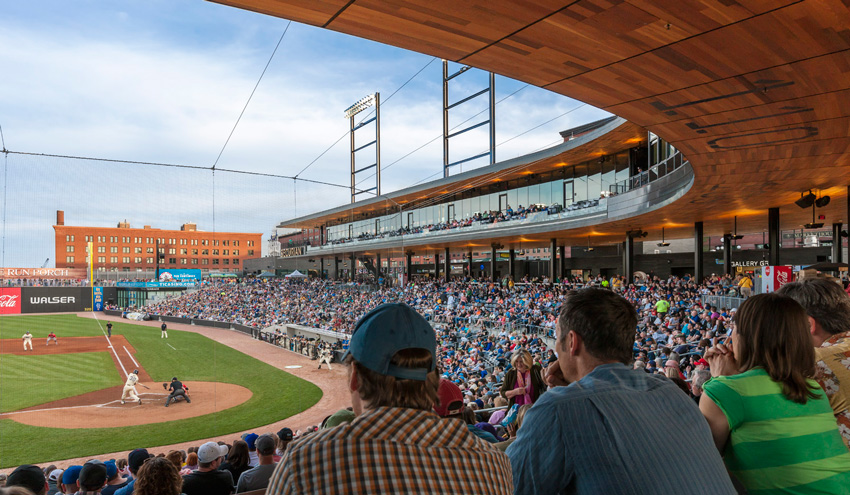Western Red Cedar
A proven material offers sustainable warmth for contemporary architecture
![]() Continuing Education
Continuing Education
Use the following learning objectives to focus your study while reading this month’s Continuing Education article.
Learning Objectives - After reading this article, you will be able to:
- Describe the uses of Western Red Cedar from ancient times to modern designs.
- Explain Western Red Cedar’s sustainability designations and pathways to LEED certifications.
- Identify design options for specifying Western Red Cedar in contemporary architecture.
- List Western Red Cedar’s proven performance characteristics.
To understand how architects and designers can bring natural warmth to modern architecture, you need look only as far as your local Crate &Barrel store. While each of the company’s stores is different, they all have a common aesthetic feature: a warm and welcoming vibe created with clean lines and the extensive use of Western Red Cedar (WRC)—a soft, red-brown timber that has thousands of years of proven use.
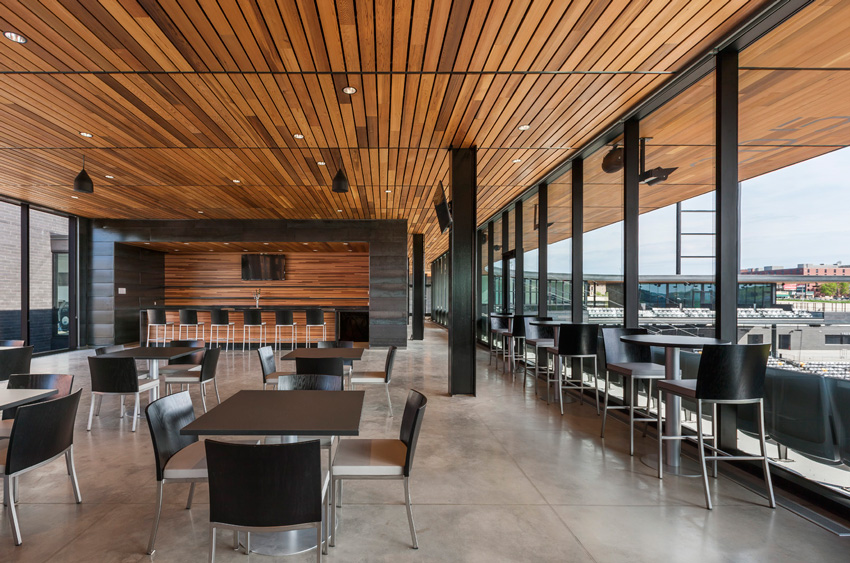
© Paul Crosby Architectural Photography
Western Red Cedar adds warmth to contemporary design at CHS Field in St. Paul. This project was designed by Ryan A+E Inc. and Snow Kreilich Architects.
The cedar features specified for each store vary. “It’s used for exterior siding, interior paneling, and ceilings, and it’s stained and painted,” says Josh DeGuire, president of Specialty Wood Products (SWP), the Colorado-based company that is the sole cedar supplier for the global chain. Some of the newest Crate & Barrel outlets, all of which use Western Red Cedar as a design theme, are in such places as Russia, the Czech Republic, Dubai, and Indonesia. The wood is shipped overseas to reinforce the chain’s signature look.
Although Crate & Barrel mostly uses clear cedar, a brushed, knotty cedar is increasingly used to mimic barn wood for interior accents. For example, stores in Georgia and Florida employ this design choice. Annually, Crate & Barrel uses between 100,000 and 150,000 square feet of WRC.
Where Modern Aesthetics and Ancient History Converge
Today’s design trends clearly indicate society’s preference for a sleek, minimalistic aesthetic. At the same time, contemporary architecture limited to glass, stone, steel, and stucco can feel cold or sterile. While clean, unembellished lines gain traction, a sense of nature via the use of wood is also sought after to evoke a connection to the natural world and a warm glow. And of importance to architects, it’s a proven sustainable material.
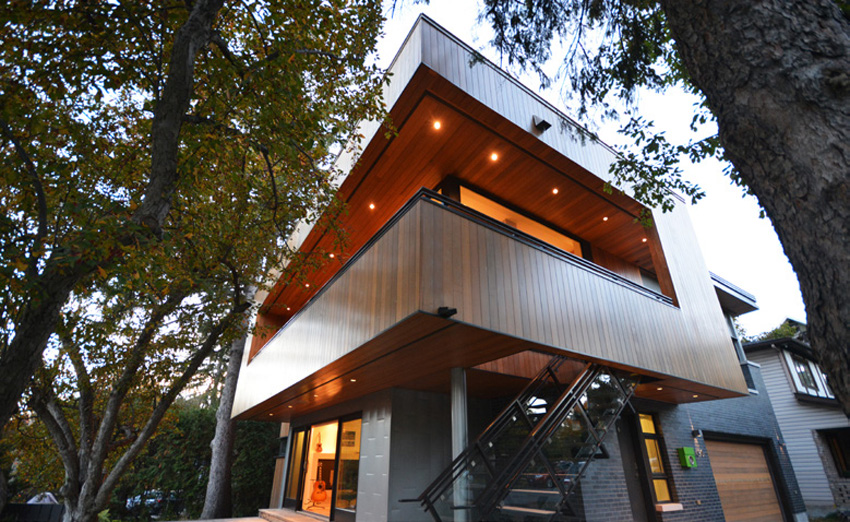
Photo courtesy of Houry Avedissian
The contemporary architectural aesthetic can feel cold or sterile, but the addition of Western Red Cedar helps overcome that. This residence was designed by Ha2 Architectural Design.
As a design guideline, there is evidence to indicate that we like some wood in our architecture, without going full-on log cabin effect.
The preference for some wood in interiors was revealed in a study on the effects of wood in hospital rooms, which was reported at the 2010 International Convention of Society of Wood Science and Technology held in Geneva, Switzerland.1
For the study, hospital employees and patients were asked to rate digitally manipulated images of three rooms: one with no wood in the room; one with wood on the floor and one wall; and one with wood on all walls as well as the floor and ceiling. The preference? The room with wood on one wall and the floor was rated most pleasant, most natural, most calming, and most secure, and as the least boring room.
Western Red Cedar, long revered for its durability or exterior applications, is a natural choice for also warming up interiors. Imbued with decidedly crisp yet rich tonal properties, the wood not only creates beautiful outdoor environments, it also enlivens traditional home decor, provoking cutting-edge architecture and inspiring innovative interiors.
“Western Red Cedar is simply one of the world’s most beautiful woods,” says Paul Mackie, known as “Mr. Cedar” in the building industry. “No man-made material can duplicate Western Red Cedar’s naturally luxurious appearance.”
Finishes, which will be discussed later, include elegant dark stains, shabby chic bleaches, traditional solid colors, and natural semitransparent stains. Western Red Cedar also offers a wide range of sizes, surface textures, and grades appropriate for many different applications.
Cedar's Historical Significance to Canada's First Nations and Native Americans
While currently trendy, Western Red Cedar is not a new phenomenon. A large number of archeological finds indicates the widespread use of Western Red Cedar in ancient native cultures. It was used extensively wherever it was found along the northwest coast of North America, including British Columbia, Washington state, Oregon, Idaho, and parts of Alaska.

Photo courtesy of the Western Red Cedar Lumber Association
While currently trending in contemporary design, Western Red Cedar has a proven history of use and performance dating back thousands of years.
Bark baskets woven in five different styles have been found near Vancouver, along with ropes and ocean-going canoes dating to 3,000 years ago. Woodworking tools such as carved antlers, dating between 8,000 and 5,000 years ago, were discovered in shell middens at an archeology site near Vancouver. Tools dating 4,000 to 3,000 years old have been found on the west coast of Vancouver Island. Wooden artifacts 1,000 years old were unearthed on the east coast of Vancouver Island.
The cedar trees and their wood have deep religious values. In a book titled Cedar: Tree of Life to the Northwest Coast Indians, author Hilary Stewart mentions a legend among the native Coast Salish people that describes the origins of the Western Red Cedar.2 The legend focuses on a generous man who gave the people whatever they needed. When the Great Spirit saw this, he declared that when the generous man died, a great red cedar tree would grow where he is buried, and that the cedar will be useful to all the people, providing its roots for baskets, bark for clothing, and wood for shelter.
Native Americans of coastal Oregon to southeast Alaska also have a long history of using Western Red Cedar. Some northwest coast tribes refer to themselves as “people of the redcedar,” using the original spelling because of their connection with the tree for their basic needs. Roots and bark were used for baskets, bowls, ropes, clothing, blankets, and rings. The wood has been used for houses, boards, ceremonial objects, totem poles, masks, utensils, boxes, boards, instruments, canoes, and vessels.
Therefore, the specification of Western Red Cedar in contemporary architecture carries with it a deep and meaningful link to the history of native cultures.
Western Red Cedar's Characteristics
The scientific name for Western Red Cedar is Thuja plicata and has one of the widest spread growth ranges on the West Coast. It is often found growing alongside Douglas Fir and Western Hemlock. It grows in lush forests and mountainsides, and also in many forested swamps and stream banks in its range.
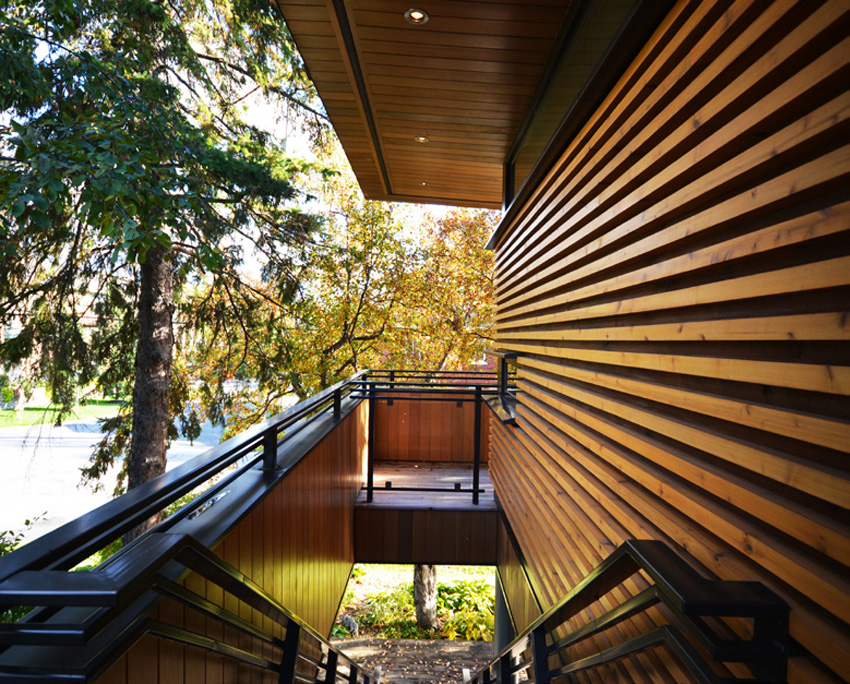
Photo courtesy of Houry Avedissian
Western Red Cedar’s scientific name is Thuja plicata. The name is derived from thujaplicin, a chemical substance that is found in mature trees and serves as a natural fungicide, thereby preventing the wood from rotting.
Western Red Cedar is one of North America’s great renewable resources. Slow growing and naturally durable, it has one of the longest life spans of any North American softwood. It produces various lengths of timber with true, straight grain.
Western Red Cedar’s celebrated durability actually reveals itself long before harvest. A report by Connie Harrington of the U.S. Forest Service, an agency of the USDA, stresses that the tree tolerates shade very well. “Cedars have a reputation for surviving in the understory with (slow) growth,” Harrington states. Further, the species’ growth rates are likely to thrive as accelerated climate change occurs. And it is “less susceptible to diseases than many other conifers.” The trees can live for more than 1,000 years.3
How Western Red Cedar Forests are Managed and Certified
Western Red Cedar is found in the province of British Columbia and grows nowhere else in Canada. Western Red Cedar was declared British Columbia’s official tree in 1988. More than 85 percent of timberland in British Columbia is certified by internationally recognized, independent, third-party forest certification agencies. The point of independent, third-party evaluations is to protect environmental values, such as biodiversity, soil, and water quality. Here’s how they work:
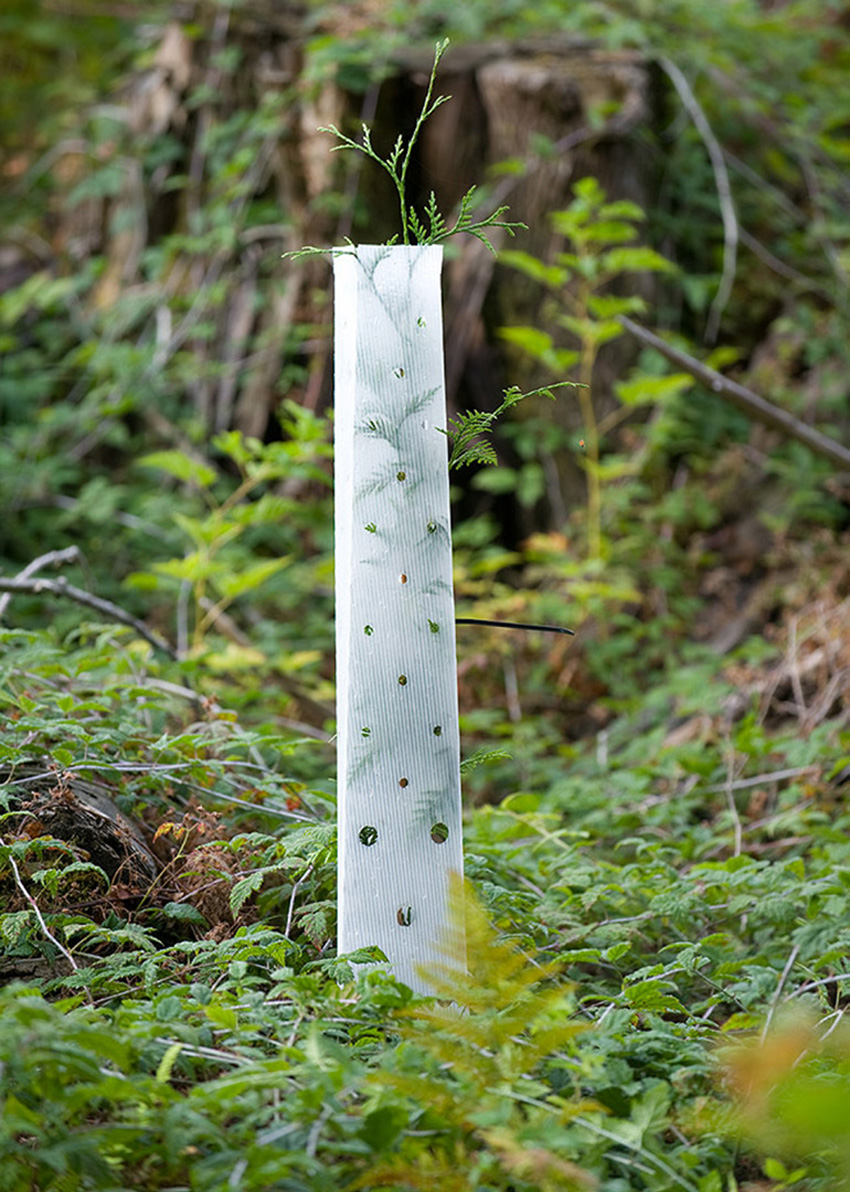
Photo courtesy of Western Red Cedar Lumber Association
More than 85 percent of timberland in the province of British Columbia is certified by internationally recognized forest certification agencies.
Evaluation: Forest companies operating in British Columbia must meet or exceed the high forest management standards demanded by government. In addition, they also have a high level of third-party certification, which gives customers added assurance that they are practicing responsible and sustainable forest management.
Environment: The forests are assessed according to rigorous, measurable, and scientific criteria that include ensuring protection of biodiversity and preserving soil and water quality.
Label and Chain of Custody: Forest products can include a label indicating they have been approved as environmentally friendly and a chain-of-custody system, which tracks a wood product from a tree in the forest through all the steps of processing and production until it reaches the consumer.
Canada is a world leader in the development and implementation of independent, third-party forest certification programs. That’s why Canadian manufacturers—in particular British Columbian Real Cedar producers—want their customers to have proof that their wood products meet the strictest of sustainability standards. Here, then, is a breakdown of the most trusted third-party certification agencies in the world:
International Standard Organization (ISO): This organization evaluates environmental management systems. Most of British Columbia’s major forest companies have certified ISO 14001 international environmental standards.
Canadian Standards Association (CSA): This association evaluates forest practices and performance using internationally recognized criteria that are adapted to local conditions through a transparent public participation process. It includes a product label and a chain of custody. The Council of European Paper Industries has ranked the CSA as among the best in the world, and the American Forest and Paper Association recognizes it as the functional equivalent of the Sustainable Forestry Initiative. By year end 2012, British Columbia had 24.7 million hectares (61 million acres) certified to CSA.

Image courtesy of Western Red Cedar Lumber Association.
In each set of bars, the product with the highest impact in that category is the benchmark (100%) and the other products are shown as a percentage relative to the benchmark. These are percentage values against a benchmark and not absolute values.
Sustainable Forestry Initiative (SFI): This initiative evaluates forest practices using a tough standard of environmental principles, objectives, performance measures, and core indicators. It is guided by an independent sustainable forest board and includes a product label. By year end 2012, British Columbia had 25.6 million hectares (63.3 million acres) certified to the SFI program.
Forest Stewardship Council (FSC): This council evaluates forest practices using 10 guiding principles adapted to local conditions using regional standards. It includes a product label and a chain of custody. By the end of 2012, British Columbia had 2.4 million hectares (about 5.9 million acres) certified to FSC.
American Tree Farm System (ATFS): Tree Farms are inspected and certified to assure proper forest management that includes the conservation of soil, water, and wildlife. ATFS is administered through a network of forest landowners, volunteer members of state and local committees and associations, national and state government agencies, inspecting foresters, forestry consultants, natural resource professionals, and private industry.
Western Red Cedar's LCAs and Comparisons with Other Products
Additional measurable indications of sustainability are included in each product’s life-cycle assessment (LCA). Measured against competitive, alternative non-wood building materials for residential decking and siding applications, the LCA performed by Canada’s leading forestry research laboratory, FPInnovations-Forintek, measured the environmental impact of various materials from cradle to grave. Complex analysis was conducted on Western Red Cedar, WPC decking, brick, fiber cement, and vinyl against a range of measurable factors, such as resource use, water use, energy use, transportation, and waste created. Western Red Cedar substantially outperformed in every category.
The LCA test results revealed:
- Western Red Cedar decking had by far the least environmental impact when compared with both virgin and recycled wood-plastic composite decking products.
- Environmental impact results remained strongly favorable to Western Red Cedar decking, even when comparing a worst-case scenario to a best-case scenario for composite decking.
- Western Red Cedar siding performed best overall in comparison with vinyl, fibercement, and brick.
In order to evaluate the environmental impacts of the life-cycle stages of siding and decking material alternatives, the life-cycle study was modeled as four distinct life-cycle stages: resource extraction and manufacturing (cradle-to-gate manufacturing), transportation to customer, installation and use, and end-of-life disposition (landfilling). Products were measured and evaluated against six criteria that include information about the environmental impacts associated with a product or service, such as raw material acquisition, energy use, carbon footprint, emissions to air, soil and water, and waste generation.
Pathways to LEED Certifications and Use of Legal Wood
The U.S. Green Building Council (USGBC) now encourages the use of construction products and materials carrying environmental performance information calculated using life-cycle assessment (LCA) through its LEED green building point system. The main driver of EPDs in North America is LEED; and new cedar EPDs (2016) contribute to LEED points. Products with third-party certification (Type III), including external verification, are valued as one-half of a point for purposes of credit achievement calculation.
Recently, the USGBC announced a new pilot alternative compliance path (ACP) credit for its LEED system that is designed to further advance environmentally responsible forest management and help rid buildings of illegal wood by promoting the use of wood that is verified to be legal.
The LEED pilot ACP builds on the robust infrastructure that has been built around responsible wood sourcing and chain of custody to test an approach to prerequisite requirements, which could serve as a model for other building materials.
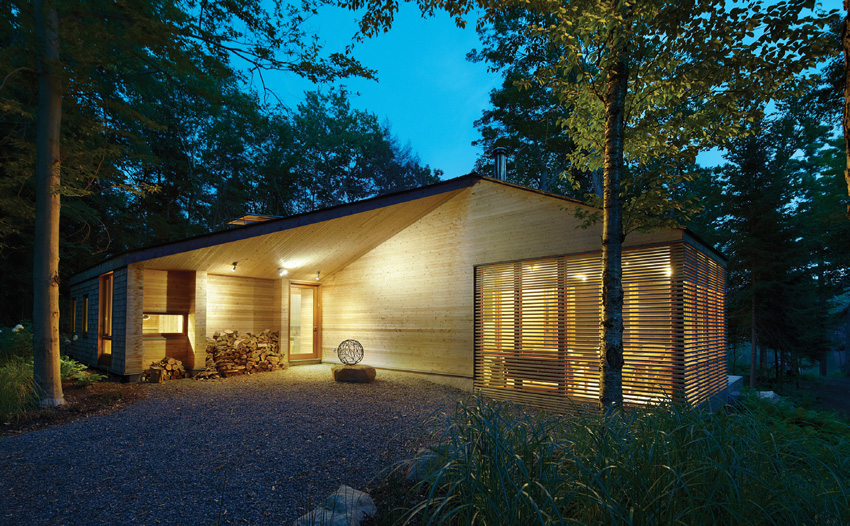
Photo courtesy of Shai Gil Fotography
The use of sustainably harvested Western Red Cedar can contribute to green building points and certifications. This Stealth Cabin residence was designed by superkül.
This new pilot ACP is applicable to both LEED 2009 and LEED v4 systems. While LEED has always rewarded leadership in materials specification, this new ACP seeks to leverage LEED’s market power by focusing attention on the significant need for more comprehensive and effective legal verification of building products. The pilot ACP is designed to address a critical piece of the supply chain and reward project teams who proactively verify that the wood they are using is legal.
“Healthy, vibrant forests are an essential piece of life as we know it,” Rick Fedrizzi, former chief executive officer and founding chair, USGBC, stated in the press release. “LEED has made tremendous strides by promoting leadership on sourcing of forestry products. We want LEED to also be a significant driver for stopping illegal logging. As we have begun looking at approaches to incentivize responsible sourcing of all materials that go into our buildings—such as concrete, steel, copper, and other materials—we recognize the need to address both the top—rewarding the best—as well as the bottom by eliminating unacceptable practices.”
Over the past 15 years, the green building industry has invested a significant amount of resources related to responsible procurement of forest products, which have taken up the vast majority of the debate about raw materials sourcing.
“This focus of the green building industry on the various wood certification standards has produced measurable progress,” Fedrizzi added. “With the pilot ACP, we are increasing the scope of LEED related to wood with an eye toward possibly applying what we learn to other industries. Beyond this credit, LEED v4 takes steps to reward progress related to all raw materials sourcing issues and encourage all sectors to continue to improve.”
“Today, it is possible to achieve the LEED wood credit and still have illegal wood in a LEED certified project,” says Scot Horst, former chief product officer, USGBC. “This is because LEED projects receive credit for a percentage of the wood on the project, rather than on all wood used. LEED is a global standard with a vision of market transformation. Addressing the illegal wood issue in LEED projects, especially in projects outside of the United States, comes at a critical time both for the global issue of illegal logging and unfair forestry practices, and also for LEED and its growing influence.”
Western Red Cedar's Proven Performance Characterisitcs
To understand why architects, builders, and homeowners are drawn to Western Red Cedar, it helps to review such factors as its beauty, character, function, affordability, and light environmental footprint.
Versatile: Western Red Cedar is pitch and resin free. That means it will accept and hold a wide range of finishes, including elegant dark stains, shabby chic bleaches, traditional solid colors, and naturally beautiful semi-transparents. Cedar also is available in a wide range of sizes, surface textures, and grades.
Sustainable: Independent studies prove that when it comes to environmental performance, natural wood is superior to synthetic products. While other building materials generate greenhouse gases, Western Red Cedar actually removes greenhouse gases from the atmosphere. And unlike brick, cement, and composites, Western Red Cedar is renewable and biodegradable. For maximum sustainability, Western Red Cedar should be sourced from the most sustainably managed forests in the world.
Durable: Western Red Cedar Heartwood is highly impermeable to water. This condition is attributed to crusty deposits in the membrane of bordered pits (tracheid openings that allow the passage of fluids), thus impeding the inter-tracheid fluid movement and resisting fluid penetration of the wood.
Lightweight: Large, open cell structure makes the wood less dense than most other softwoods. This quality makes it easier to move from place to place on the job.
Effective Insulator: Western Red Cedar’s low density increases the insulation of a home by transporting less heat through interior wall paneling or exterior wall siding than brick or stone, vinyl or gypsum drywall. Conversely, it helps keep interiors warmer in cold weather.
Acoustic Effectiveness: Western Red Cedar’s open cell structure means it helps block noise. As an interior paneling or exterior siding, the low density of Western Red Cedar makes it an acoustical barrier of much greater quality than many products marketed for those applications.
Rot Resistant: Thujaplicins, chemical substances found in Western Red Cedar, serve as natural fungicides, thereby preventing the wood from rotting. This effect lasts around a century even after the tree is felled.4
How to Specify Grades of Western Red Cedar in Contemporary Architecture
The look and feel of an architectural design can shift dramatically depending on the grade of Western Red Cedar chosen for the project. Common products in include bevel siding, pattern siding, lap siding, board and batten siding, trim boards, and decking.
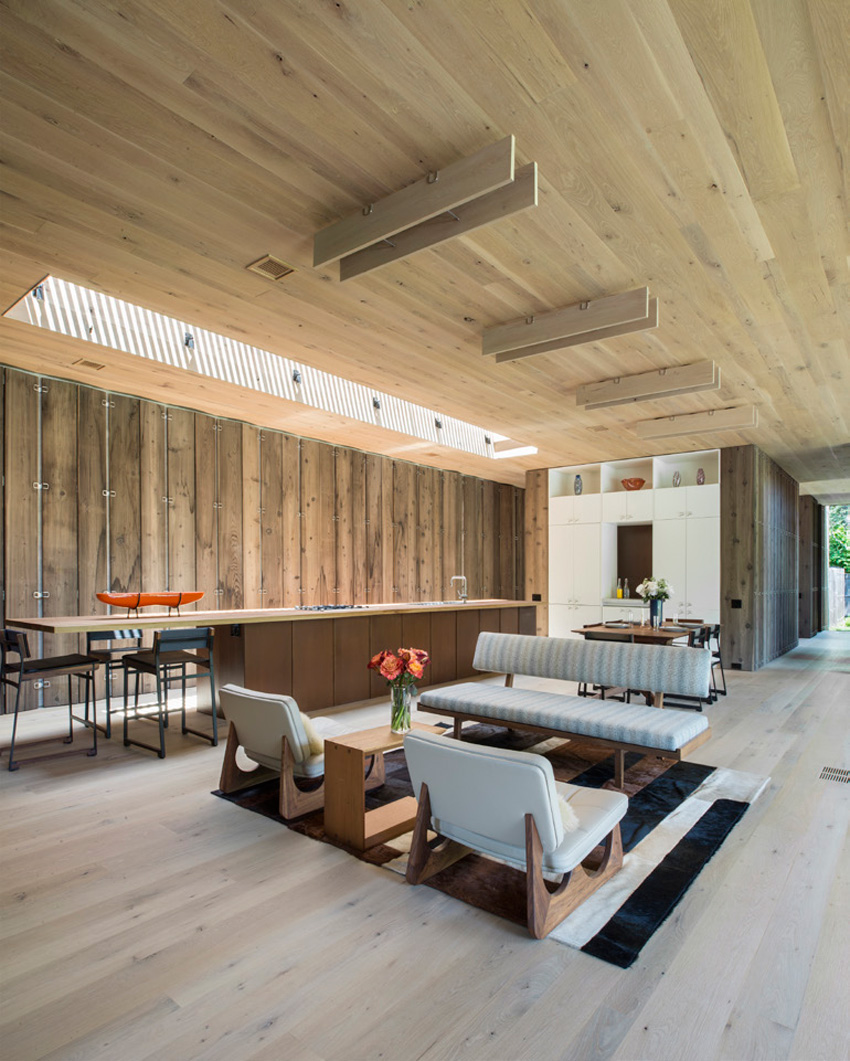
Photo courtesy of Bates Masi + Architects
Multiple grades available of Western Red Cedar allows for a wide range of uses and aesthetics. This residence was designed by Paul Masi of Bates Masi + Architects.
Western Red Cedar bevel siding is the most widely used cedar siding type. It is produced by resawing lumber at an angle to produce two pieces thicker on one edge than the other. The manufacturing process results in pieces with one smooth face. The other face is saw textured or smooth depending on the grade and customer preference. Bevel siding is installed horizontally and gives an attractive shadow line that varies with the thickness of siding selected.
Bevel siding is available in clear and knotty grades. Clear siding gives premium quality appearance and is ideal for prestigious, upmarket applications. Clear Vertical Grain Heart is the highest bevel siding grade and is kiln dried. Pieces have a smooth face of decay-resistant Heartwood and are free from growth characteristics that affect appearance or performance. Pieces have excellent dimensional stability and hold finishes exceptionally well. The next grade, A Clear, has a fine appearance that allows only slightly more growth characteristics than Clear Heart.
Knotty siding has warmth and casual charm and is specified for homes, cottages, clubhouses, and applications where a rustic appearance is desired. Rustic Grade bevel siding works well as sidewall covering where the distinctive charm of a rustic saw textured appearance is desired. This grade allows limited characteristics that do not detract from serviceability.
Some manufacturers also produce finger-joined and/or finger-joined and edged-glued siding and trim boards in clear and knotty grades. The precision-fitted joints are virtually invisible and stronger than the surrounding fiber. Finger-joined siding and trim is available in long lengths of up to 16 feet and 20 feet. They provide the handsome appearance and all-weather performance of other premium cedar products. Builders tend to appreciate both the convenient long lengths and the speed and ease of installation with fewer field joints. Knots and other natural features define the visual character of knotty sidings. In this grade, knots are sound and tight. It is usually available kiln-dried and smooth or saw textured. Some companies may supply this grade with knots glued on the reverse face.
Architect Knotty products are intended to be fully usable with resawn or smooth face exposed after trimming to fit stud wall spacing. It contains no open characteristics or through defects. The product allows the use of adhesives on the reverse face to secure knots and is particularly well suited for factory priming or finishing.
The term pattern sidings describes a variety of siding products in which the board has been machined on the edge(s) and face(s) to produce siding with interlocking or overlapping joints and with smooth surfaced or rough sawn faces. These sidings fall into two broad groups: tongue and groove and shiplap.
Western Red Cedar tongue and groove is widely used for its good looks and versatility. It adds to design innovation because it can be installed horizontally, vertically, or diagonally, each method giving a distinctly different look. Tongue-and-groove siding is available kiln dried with rough or smooth faces.
Tongue-and-groove siding is manufactured in clear grades suitable for a more formal, elegant appearance, particularly when pieces are smooth faced. Knotty grades are in demand for their smart yet casual look. In both cases, they may be manufactured as a reversible product. Shiplap sidings are supplied kiln dried in a variety of patterns in clear or knotty grades and with a smooth or saw textured face. Lap sidings are produced and graded to the intended exposed face.
Channel siding is a popular type of shiplap siding and is used whenever a rustic appearance is desired. A versatile siding, it can be installed vertically, horizontally, or diagonally. In channel siding, the profile of each board partially overlaps that of the board next to it, creating a channel that gives shadow line effects, provides excellent weather protection, and allows for dimensional movement. Channel siding is most commonly available in knotty grades, but clear grades are available by special order.
Grades of Western Red Cedar Decking
Whether used for a traditional deck or a ceiling application to add warmth to a contemporary design, decking is available in a number of grades.
Architect Clear is considered the ultimate in appearance. Its fine-grained appearance should meet the needs of the most demanding clients. All aspects of manufacturing and quality control are performed to the highest standards of the lumber industry. This is an exclusive product that is usually manufactured to individual order.
Custom Clear is a high-quality product that combines the stability and beauty of Western Red Cedar with a sophisticated clear appearance that will please the most discriminating tastes. Its finely machined surface shows limited characteristics that do not detract from its appearance. It is a natural choice for custom residences and other applications where fine woodwork is desired.
An architectural knotty grade has been described as rustic charm at its best. It is sound and tightly knotted. The smooth, skip-free dressing over the entire face makes it the ideal deck surface. For architects and specifiers, it would be a top choice where the natural beauty and lasting charm of a knotty deck are desired.
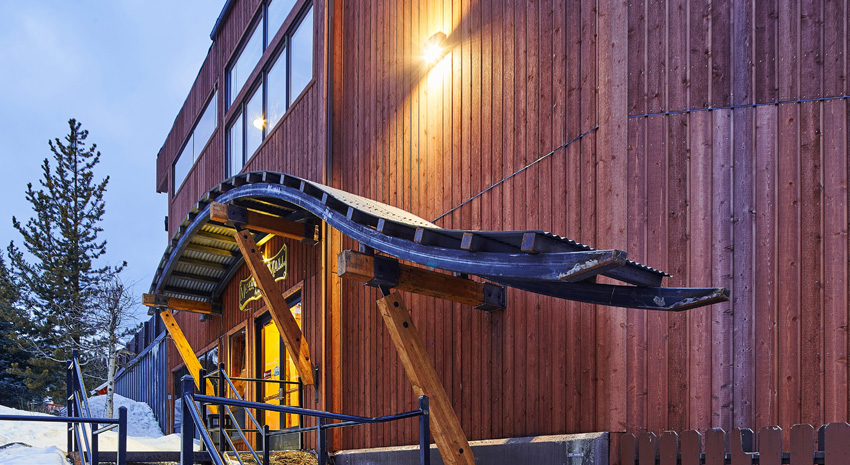
Photo courtesy of Ryan Day Thompson
Big Sky Ski Resort Mountain Mall by Centre Sky Architects Ltd.
Finishing Options
To achieve the desired aesthetic and performance results, the designer or specifier should become familiar with finishing options. And Western Red Cedar offers a myriad of appropriate choices. The species is rich in extractives that enhance durability yet free of the pitch and resin found in other softwoods. That makes it well suited for a robust range of finishes, from lightly toned semitransparent solutions to two-coat solid colors. Cedar ranks at the top in its ability to accept and maintain a finish. Here are some options:
Opaque Finishes
Paint offers the greatest surface protection against weathering and wetting by water while providing color and concealing some of the wood’s characteristics. Although paint can reduce wood’s absorption of water, paint itself is not a preservative. Alkyd oil-based primers usually offer the best shield against discoloration by water-soluble extractives. Latex paint, particularly 100 percent acrylic formulations, remain more flexible with age and are better able to accommodate dimensional changes, as they stretch and shrink as the wood expands and contracts.
Solid-color stains are simply opaque finishes with fewer solids than paint. Available in a wide spectrum of hues, solid-color stains obscure the wood’s true color but allow some of the natural characteristics and texture of cedar to remain.
Solid-color stains perform best on textured surfaces. They are nonpenetrating and, like paints, form a film. A stain-blocking primer should be applied first, followed by a 100 percent acrylic latex-based topcoat.
Paint and solid finishes are the longest lasting on Western Red Cedar siding and trim.
Natural Finishes
Water repellents and water-repellent preservatives may be applied to cedar used above ground. These formulations reduce water absorption in the short term. The addition of a fungicide that inhibits the growth of mildew and decay fungi will further increase wood’s durability.
Semitransparent stains may be latex or oil based. The semitransparent nature of the stain, due to its low solids content, does not block all UV rays, and some will reach the wood’s surface. Latex stains do not penetrate the surface and may form a film.
It is important to note that transparent, nonflexible, film-forming finishes such as lacquer, shellac, urethane, and varnish are not recommended for exterior use on cedar. UV rays can penetrate the transparent film and degrade the wood. Regardless of the number of coats, the finish will eventually become brittle, develop severe cracks, and then fail.
A Word about Application of Finishes
How a finish is applied to cedar is as important for durability and good performance as is the finish-substrate combination chosen for the job. Finishes can be brushed, rolled, sprayed, or applied by dipping. The application technique, the quality and quantity of finish applied, the surface condition of the substrate, and the weather conditions at the time of application can substantially influence the life expectancy of the finish. The application guidelines suggested here should be followed in concert with the manufacturer’s directions for the product.
For optimum performance, the Western Red Cedar Lumber Association recommends that Western Red Cedar be preprimed or prefinished on all six sides prior to job site delivery. Factory priming, as the name implies, is performed in an industrial setting where a machine coating process applies a primer to all six sides of each piece. The coated pieces are then dried prior to shipment to the job site. Preprimed siding and trim boards delivered to a job site should be kept dry and clean prior to installation. All field cuts should be resealed with a primer prior to the pieces being installed. Top coating should be completed as quickly as possible, as most primers are not intended to be exposed to natural weathering for more than 90 days.
Factory finishing is similar to the above process, however, it allows for the additional application of one or two topcoats of acrylic latex paint, solid stains, or natural stains in job lot quantities and in the colors selected by the builder/homeowner. It is important not to overdrive nails during installation of factory-finished siding, as this will damage the surrounding wood and coating. Overdriven nails must be remedied immediately by filling the depression with exterior grade wood putty or caulk specifically designed for this purpose. The subcontractor should touch up any repairs or field cuts, taking care not to smear the topcoat. When properly done, factory priming/ finishing provides:
- The application of a uniform coating at the recommended coverage of the primer/stain to all six surfaces of each piece (face, back, edges, and ends)
- A controlled environment to permit proper curing of the finish
- The wood with a coating to protect it from exposure to sunlight (UV degradation) and surface contamination by mildew and dirt
- An elimination of lap marks, streaks, and shrink lines after installation
- The ability to install products at any time of the year
- A product that often comes with a coating warranty
Conclusion
An architect who specifies Western Red Cedar in a contemporary design brings together the soul of native cultures with the clean lines of modern architecture. With products available from sustainably managed forests and LCAs and EPDs that indicate the product’s favorable green characteristics, Western Red Cedar can now help earn LEED points toward a green certification. While the reddish wood harvested from the Pacific Northwest, British Columbia, and Alaska is enjoying current trendiness, it has an unusually long proven history of stability and durability. When the designer specifies Western Red Cedar to bring warmth to the modern styling of a commercial building, a school, a civic building, or a custom home, the melding of history and modernity comes through. By learning about the history and geography of Western Red Cedar, along with its proven qualities and scientifically quantified sustainability, the architect or specifier is in a better position to consider this wood to bring a warm aesthetic to a modern building.
End Notes
1Nyrud, Anders Q.; Bysheim, Kristian; and Bringslimark, Tina. Health Benefits from Wood Interior in a Hospital Room. Proceedings of the International Convention of Society of Wood Science and Technology and United Nations Economic Commission for Europe – Timber Committee. 11–14 October 2010. Web. 17 November 2016. www.swst.org/meetings/AM10/pdfs/WS-56%20Nyrud%20Paper.pdf.
2Stewart, Jon. Cedar: Tree of Life to the Northwest Coast Indians. 1 March 1995. Web. 28 November 2016. www.amazon.com/Cedar-Tree-Northwest-Coast-Indians/dp/0295974486.
3Harrington, Connie. Biology and Management of Western Redcedar. U.S. Forest Service. 21 March 2016. Web. 17 November 2016. extension.oregonstate.edu/clackamas/sites/default/files/harrington19bredcedar1-40ppt.pdf.
4Thuja plicata. Wikipedia. Web. 17 November 2016. en.wikipedia.org/wiki/Thuja_plicata.

|
The Western Red Cedar Lumber Association represents quality “Real Cedar” producers, distributors, and retailers throughout North America. Founded in 1954 and known as “the voice of the cedar industry,” WRCLA offers extensive resources to assist with selection, specification, and quality standards. For more information, visit www.realcedar.com. |



